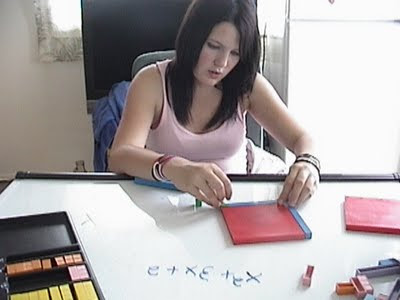
Since that square root video I made in the last post many classes have taken place. In this post, I will focus on the classes that used algebra for the primary cross concept method. I use it to teach addition, multiplication, division, factoring
and "algebra." Occasionally I use it to teach other concepts as well, but today we focus on basic operations.
 The work above was done by a seven year old male student. Our focus was on addition and then on multiplication and lastly on algebra.
The work above was done by a seven year old male student. Our focus was on addition and then on multiplication and lastly on algebra. The idea is simple.
Algebra is abstract mathematics. This method makes the abstract concrete, therefore we can start teaching
concepts using algebra. We start simple and work our way up to the complex, keeping
the 5 basic concepts in mind and using
three period lessons as needed to make sure everyone is on the same page as it were. This is CONCEPT based teaching NOT memorization or formula based teaching. I teach by example with the understanding that the first three times are the baby steps. First time is new. Second time is familiar. Third time is "we did this already, let me do it..."

These two "simple" factoring problems are easy to solve once they have te blocks to work with. The point is not to amaze and astonish the stodgy, well entrenched teachers of mathematics by training monkeys to factor polynomials. The point is to make impressions on the child's memory. It takes about 18 impressions to get a fact from the short term to the long term memory. Some methods use wrote drills, where the child is subjected to seemingly endless worksheets. Here, when they factor
x2 + 7x + 12 They learn that 4 + 3 = 7 and that 4 x 3 = 12 simple enough. They also learn that if the whole rectangle is 12 and one side is 3 the other side must be 4...lastly they can see that if the whole thing is x
2 + 7x + 12 the factors are (x + 3)(x +4), which means that if the whole thing is x
2 + 7x + 12 and one side is (x + 3) the other side must be (x + 4).
There is a whole lot of math going on in one problem...and they learn and discover all by themselves. Further the trial and error teaches them quite a bit also, and in this method they are not wrong just acquiring more information, because the model is self-correcting due to the fact that success means a rectangle is formed. Hence the slogan "if you can count to nine, tell if something is same or different or not and identify a rectangle, we can teach you math."

Here we have some team work going on. 4 students, 2 teams. The students are racing to try and finish this battery of problems:
x2 + 7x + 12 x2 + 9x + 18
x2 + 9x + 14 x2 + 10x + 25
x2 + 10x + 30 x2 + 12x + 32
They have to factor them and draw a picture in their notebooks. There is an age range of 8 to 14 in this group. Each students is getting a little something different from this exercise, the youngest are still working on addition and multiplication facts, the older students are "doing algebra" all of them are building self esteem and confidence because they "know" algebra is supposed to be hard.
These problems got done a lot faster because they were racing, which is why I like a group as compared to solo lessons.
This post is FAR from finished...






